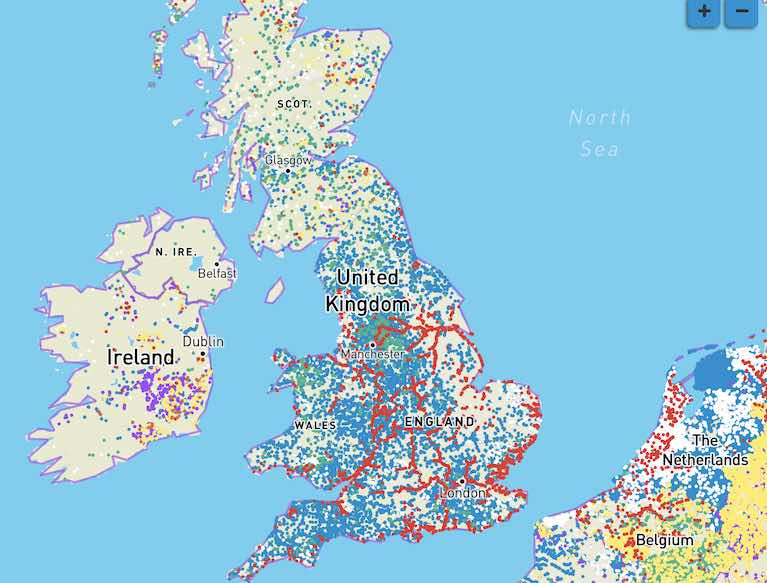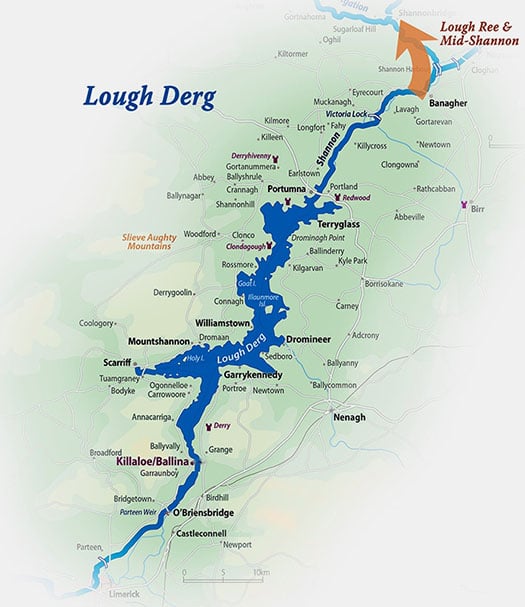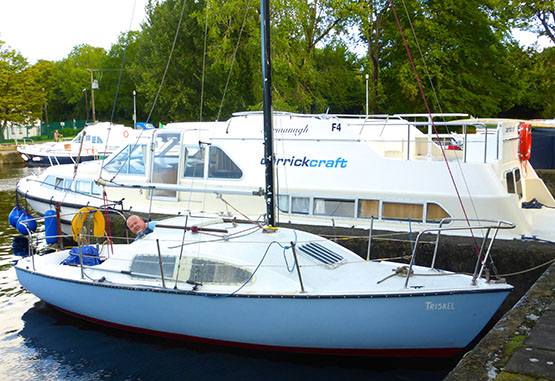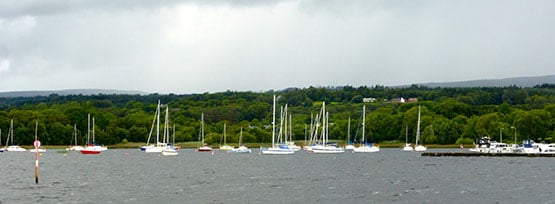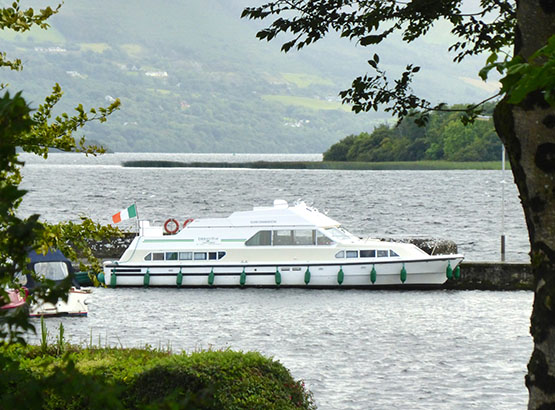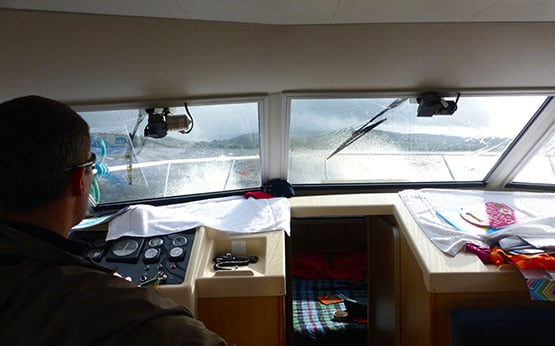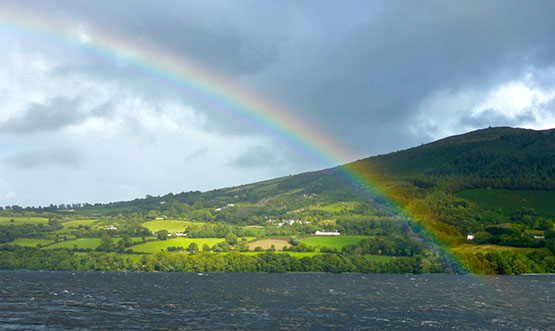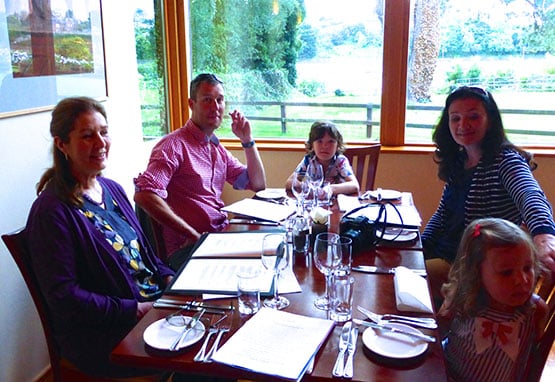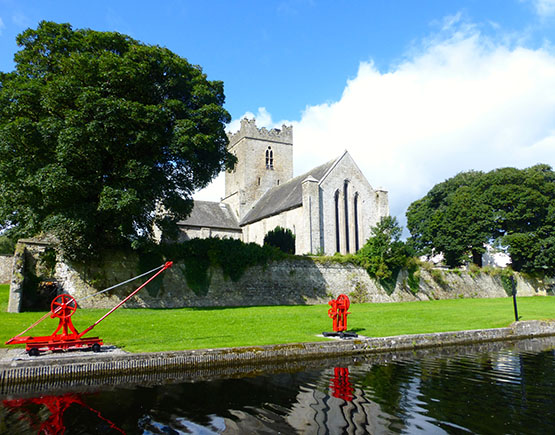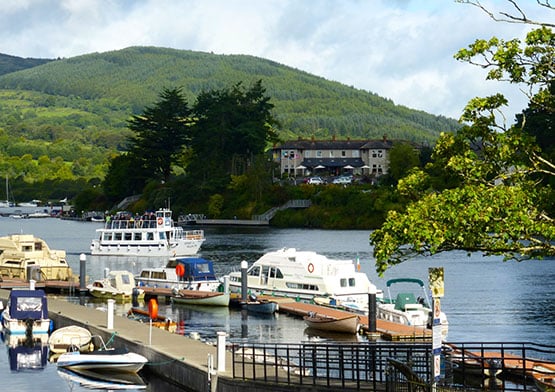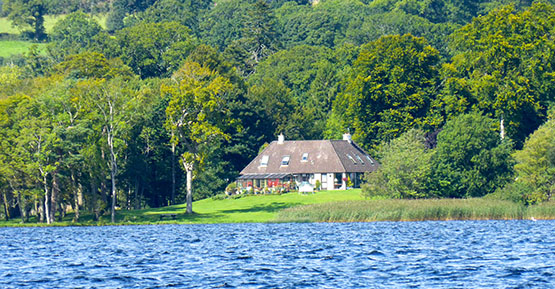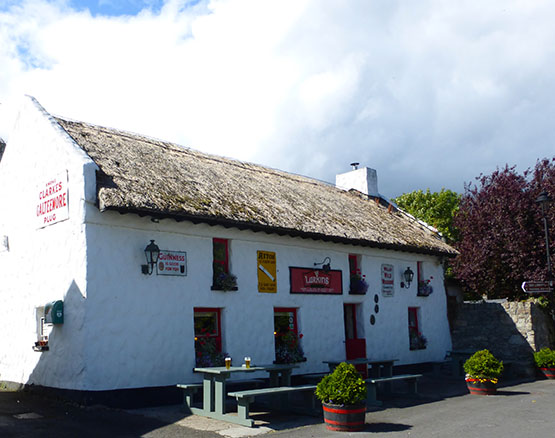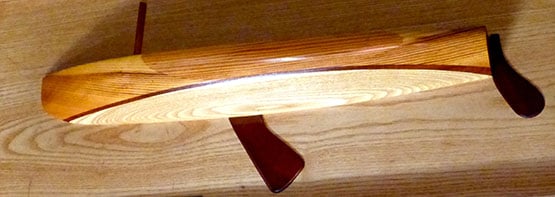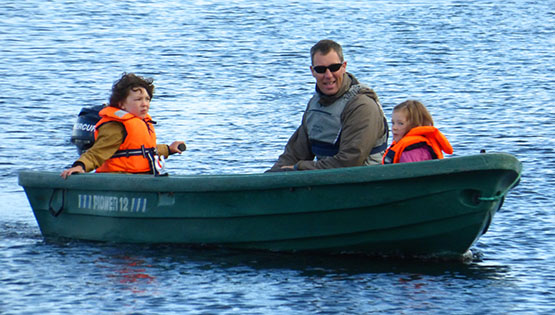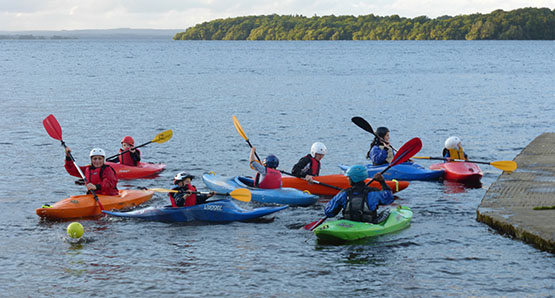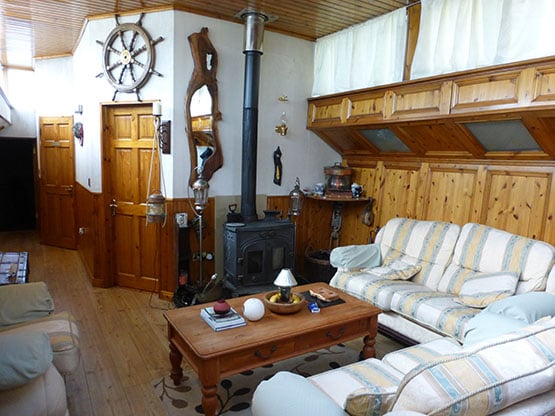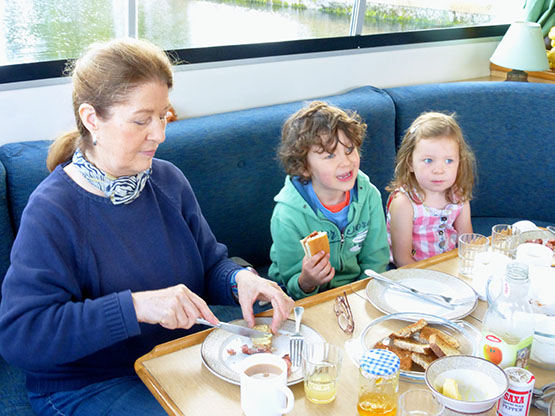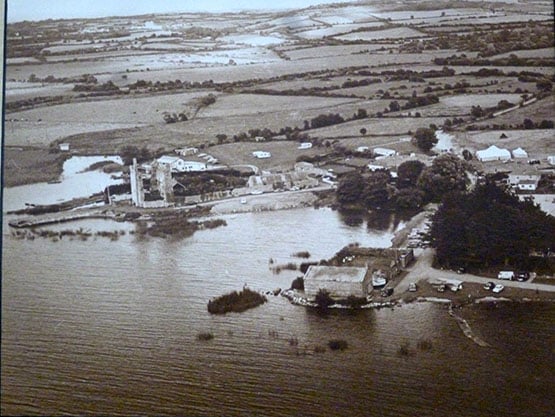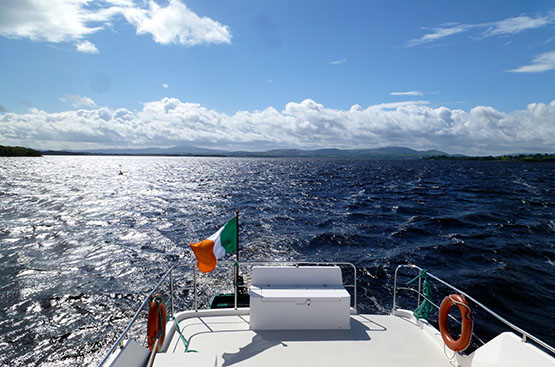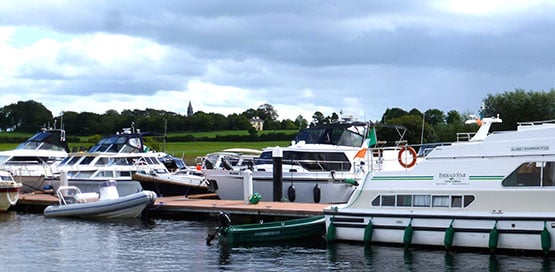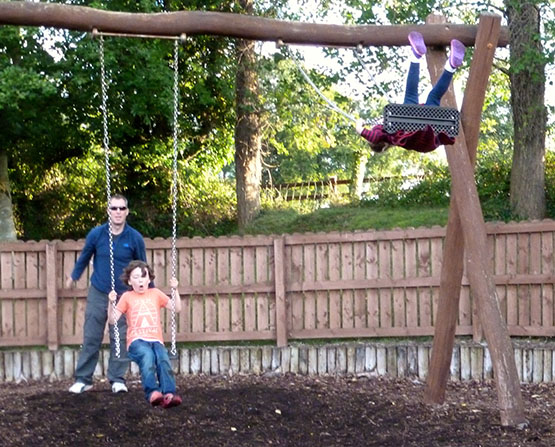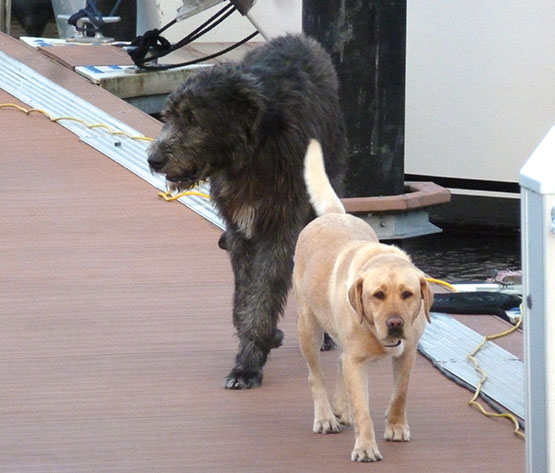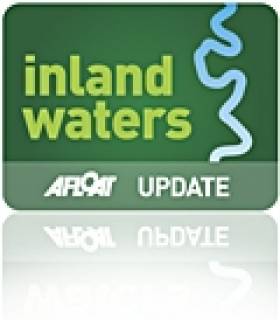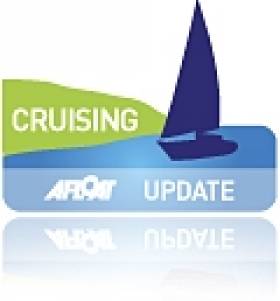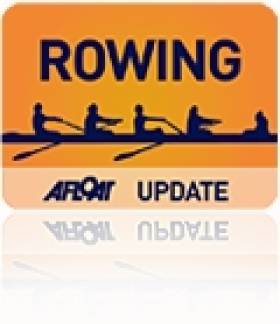Displaying items by tag: River
Diverting streams and rivers to irrigate crops or provide drinking water may “significantly extend” the time microplastics spend in river catchments, new research states.
Diverted water from rivers disperse tiny plastic particles across farmland from where they may be flushed back into other watercourses or neighbouring catchments, the research by an international group of scientists led by the University of Birmingham has found.
The findings have been published in scientific journal Water Research.
The research team studied two paired rivers in Colorado, North America – the Boulder Creek and its less urbanised tributary, South Boulder Creek.
The researchers found that microplastic concentration patterns in both rivers were related to the degree of catchment urbanisation.
Data from both streams suggests a link between microplastic concentration and urbanisation, they state.
They found that microplastic concentrations in Boulder Creek with a more urbanised catchment were higher in both surface water and sediment than in South Boulder Creek.
Microplastic concentration increased in the downstream direction when passing more urbanised areas, they noted.
“We discovered strong links between the degree of urbanisation in the river catchment and observed river microplastic concentrations, highlighting how human activities resulted in immediate increase in microplastics in this mountainous catchment,” lead author Anna Kukkola from the University of Birmingham said.
“A key novelty of this study is the application of the loading approach which is used here for the first time for the quantification of microplastics fluxes,”she explained.
This enabled the team to “not only identify microplastic sources, but also determine the downstream evolution of microplastic transport patterns, and in this case also the diversion of microplastics out of the river catchment”, she said.
“These results for microplastics are consistent with our results for other urban-derived elements such as chloride, where we are seeing three to nine times more loading in the more urbanized Boulder Creek watershed,” Co-author Rob Runkel, from the United States Geological Survey,said.
The international team furthermore discovered that the magnitude of flow diversions from both streams resulted in large quantities of microplastic being removed from each stream and being transported out of their actual catchment.
They measured microplastic removal through flow diversions of over 500 microplastic particles per second (or 1,800,00 per hour) from the two rivers studied.
To put this into perspective,the researchers state that in 2012, 241 km3 of water were diverted for agricultural purposes in North America alone, with 2,670 km3 having been diverted globally.
By using conservative estimates based on the >63 µm particle threshold of their study, the researchers say that they estimated that this could result in around 41 trillion microplastic particles being redistributed out of river networks into the terrestrial environment in North America every year.
They calculated as many as 459 trillion particles could be redistributed globally.
“How we manage our streams and rivers can have a substantial impact on the transport of microplastics, yet these effects have not been incorporated into global models that assume downstream convergence of microplastic fluxes along river networks,” co-author and principal investigator Prof Stefan Krause, from the University of Birmingham, said.
“Our current models may, therefore, underestimate the quantities and residence times of plastics held in river catchments and overestimate the speed with which microplastics are transported into our oceans,”Krause said.
While toxicity assessment was not a focus of the current study, co-author Professor Iseult Lynch from the University of Birmingham said the “results of this study are highly relevant for estimating ecotoxicological impacts on aquatic and terrestrial environments and ecosystems”.
Participating institutions with the University of Birmingham included the United States Geological Survey, USA; Centre for Environment, Fisheries and Aquaculture Science, Lowestoft, UK; and University of Lyon, France.
The research was part of the Leverhulme Trust-funded 100 Plastic Rivers project
The paper is available here
Solution to Europe's "Broken" Rivers Identified in Research Involving UCC
Europe has some of the "most fragmented" rivers in the world with at least 1.2 million instream barriers, according to a newly published study.
An EU project involving University College Cork (UCC) team of researchers has identified thousands of large dams and a myriad of weirs, culverts, fords, sluices and ramps as the "main culprit of fragmentation".
It calculates that there are at least 0.74 barriers per kilometre of stream in Europe, and has recorded same in what it describes as the "first comprehensive pan- European barrier inventory".
The Amber Barrier Atlas shows the extent of this fragmentation is "much higher than anyone had anticipated", according to river geomorphologist Barbara Belletti who is now based at the CNRS, the French National Centre for Scientific Research.
Amber co-ordinator Carlos de Garcia de Leaniz said that many of the barriers are obsolete, and removing them "provides unprecedented opportunities for restoration".
The project results will feed into the EU's new biodiversity strategy and will help to reconnect at least 25,000km of Europe's rivers by 2030, he said.
UCC research professor Prof Philip McGinnity said that the project involved attempting to identify those areas of a river where Atlantic salmon are "stressed, in distress or excluded".
UCC Environmental Research Institute director Prof Sarah Culloty said the impact of the river barriers identified would be exacerbated by global warming.
The data would be critical to managing future risk, prioritising action and co-ordinated responses, she said.
UCC's head of the school of biological, earth and environmental sciences Prof Andy Wheeler said he was very concerned that recent Environmental Protection Agency reports showed that the ecological quality of Ireland's surface waters continued to decline, with nearly half of the water bodies in Ireland failing to meet objectives set in the EU Water Framework Directive.
Restoring connectivity by removing obsolete barriers would make an "important contribution in helping to improve conditions", he said.
The Amber project, funded under the EU's Horizon 2020 research and innovation programme, has developed tools and simulations to help water companies and river managers make the most of barriers and minimise ecological impacts.
It has improved fish migration at the Poutes dam in France using "adaptive management strategies" as one of a number of initiatives. A citizen science app to recover river barriers in Europe has also been developed, known as the Barrier Tracker.
More here
Hire A Cruiser on Lough Derg & Explore the Shannon In Autumn
Ireland is a country of seaways, and waterways which are dominated by the majestic River Shannon. On our island, you can never be more than sixty miles from the nearest navigable bit of sea. Add in the myriad of inland waterways – whether canals, rivers, or lakes – and you have an enthusiastically watery country where it is possible for everyone to have a floating boat berth of some kind within an hour’s journey – and usually much less – from their home.
Afloat.ie’s W M Nixon has been cruising our inland waterways in detail for longer than he cares to admit, though he will concede his first venture on fresh water was in command of a 14ft clinker-built sailing dinghy with a tent, a cruise which took place well back into the depths of the previous millennium. But it’s an experience you’ll always wish to repeat as often as possible, and just last week he found himself going again to the waters and the wild, with a family cruise of three generations on the River Shannon’s great inland sea of Lough Derg.
Journeying westward to join the good ship Slaney Shannon Star at Portumna on the frontiers of Connacht, the car radio was warbling on about the poor weather, and wondering why in England they persist in having their final summer Bank Holiday on the very last weekend of August, instead of having it earlier when the chances of good weather must be better.
As it happens, we know that the chances of good weather at any time in the summer of 2015 were slim enough, though it was briefly present just now and again. Be that as it may, the reasons for taking your “summer holiday” as late as possible in the season seem obvious. Even in this era of flexi-time and working from home and project outsourcing or whatever, the idea of clearly-defined work time and holiday time are still ingrained in us. And of all our traditional holidays, surely it is the summer holiday which is the most avidly anticipated?
Anticipation is usually the keenest and often the best part of any supposedly enjoyable experience. And it’s an altogether more positive and youthful emotion than nostalgia, which soon reeks of sweet decay. Thus the later in the summer you can locate your summer holiday, the longer is the enthusiastic anticipation. So when we got an invitation early in the Spring for some days of family cruising on a fine big Shannon hire cruiser on the magnificent inland sea of Lough Derg in the last week of August, we leapt at it.
Yet let’s face it, it’s something of which you’d be very chary were the planned cruise on the sea, even down in our own lovely West Cork. They may have started the Fastnet Race this year as late in the season as 16th August but, as the late great Tom Crosbie of Cork Harbour was wont to observe, no prudent navigator would really want to have his beloved boat west of the Old Head of Kinsale after August 15th.
However, thanks to Ireland’s wonderful inland waterways, and the mighty Shannon and Erne river systems in particular, we have an all-seasons cruising ground sufficiently varied for even the saltiest sea sailor when summer is gone. And in that last precious week of August – when just one balmy moment of a late summer’s evening is worth ten such in June – you get the perfect combination for a refreshing break from routine and a thoroughly good time with it, with the country looking its lushest best, a marked contrast to spring when it is raw and bare.
Not least of the attractions of a three generations cruise is that the duties of the grandparents and grandchildren are simply to have a good time. It’s the middle generation who are there to provide planning and management. So apart from simply turning up in Portumna at the required time on a Tuesday afternoon, our only task was to get a proper lifejacket for Pippa the Pup, who isn’t really a pup, she’s a three-year-old miniature Jack Russell terrier, but there’s still a lot of the puppy in her. As it was the only job we’d to do, it got huge attention, but thanks to CH Marine’s crisp online service, Pippa had her new outfit many weeks before joining the boat, and almost immediately she realized that wearing the lifejacket was all about having a good time, so no problem there.

Our little skipper - Pippa with her new lifejacket. Photo: W M Nixon
We eased ourselves gently into the Shannon pace by stopping off from the journey westward in Nenagh for lunch at Country Choice, Peter & Mary Ward’s wonderful little food emporium. They don’t so describe it themselves, but “emporium” is the only word to describe a miniature Aladdin’s cave of goodies and wonderful food. This energetic couple were in something of a state of excitement, as the entire Ward operation had just received the word that they were short-listed for an award in the “Best Shops in Ireland” competition, the announcements to be made that weekend.
So it gave us something more to anticipate as we cruised Lough Derg during the following five days, for although much of our mini-voyaging was done along the luxuriant “Tipperary Riviera”, the fact that Tipperary provides some of the best agricultural produce in Ireland does not necessarily mean that it’s a county of foodies. On the contrary, at times the Tip cuisine is very basic indeed, ignoring some of the region’s finest specialities. So Country Choice in Nenagh and the Wards’ famous and enormous stall at the weekly display on Saturdays in the Milk Market in Limerick are beacons of hope and places of cheerful pilgrimage for those who think we Irish could make better use of our wonderful natural local produce.
Portumna at the north end of Lough Derg is a strategically vital crossing of the Shannon – the next bridge is well to the north at Banagher – so inevitably Portumna is a workaday, strung out sort of town with a decidedly utilitarian air to its hire cruiser base at the evocatively-named Connaught Harbour. But the word is that Waterways Ireland have some worthwhile plans to upgrade the entire Portumna-Shannon-Lough Derg interface, though it won’t include replacing the swing bridge which takes the main road across the wide river. Our skipper was already devising a cunning scheme to deal with the dictatorship of the bridge’s opening times even as we were arriving aboard and exchanging a hurried hullo and goodbye with the previous generation on the distaff side, who had cruised with son-in-law, daughter and grandchildren up to Lough Ree.
The vessel at the centre of this hectic multi-family interchange was the 42ft Slaney Shannon Star, a fine old workhorse which has been giving sterling service to Emerald Star Line clients for more than two decades. In fact, the Shannon Star Class is quintessential Emerald Star, as just 15 of them were built by Broom’s of Norfolk, and they were exclusively for the Irish company, which worked closely on the design and specification to produce the perfect boat for Shannon cruising. This creative combination produced a comfortable and practical non-nonsense layout, with a straightforward finish which doesn’t pretend to be anything unnecessarily fancy, and a useful big Perkins 76hp diesel which gives the very able and “lakeworthy” hull a cruising speed of 7 knots.

Slaney Shannon Star in the Castle Harbour at Portumna, ensign up and ready to go. Photo: W M Nixon

This layout plan gives the broad outline of the Shannon Star’s very effective accommodation, but the forward cabin is roomier than shown, with proper gap to open the door fully.
Within this package, as the layout plan shows there is comfortable accommodation for six without using the settee berths in the saloon, there’s also an extra berth in its own little cabin just under the in-saloon steering position (it became Pippa’s cabin when we were ashore to dine), and while steering from the inside position is very comfortable with good visibility, the flybridge offers splendid views and is sufficiently large to be sociable with it.
Those who sailed with our son David when he was campaigning the likes of the Corby 36 Rosie (now Rockall III) and other offshore racing machines a decade ago will know that he thrives on planning and execution, while his wife Karen is more than a match for him. Thus for Georgina and Pippa and me and Matthew (aged 6) and Julia (aka The Diva) age 3, it was just case of being here and going with the flow and being prepared for enjoyment, for there was a lot of that.
David’s plan for the first evening in Portumna was typical of the man. They’d spent a fair bit of the day completing the final stage of the long passage down-Shannon from Lough Ree, so time ashore in a hospitable environment with food available was the target. He came up with the scheme that we’d go for supper at the very characterful Ferry Inn just across the river. But before that, we’d take the boat through the swing bridge at the 7.45pm opening, and berth her at the pontoon immediately below the bridge, which would shorten the walk to the inn, and also make it free choice for departure time in the morning.
But this was only the beginning of the man’s ingenuity. Supper was well under way in the pub when he suggested that if the senior men didn’t linger too long over the puddings, they could use the last of the daylight to take the boat the mile or so to the little harbour at Portumna Castle, while the women and children – by now immersed in various electronic games and slow eating – could follow when ready by taxi.

We wanted a characterful pub with good food to start the cruise, and we found it at the Ferry Inn beside Portumna Bridge. Photo: W M Nixon
Sounds crazy, but it was a move of genius, for the berth beside the bridge is noisy with the road traffic and doesn’t give a sense of being away from it all, whereas the tiny harbour at the castle is pure holiday setting. The only fly in the ointment of this perfect plan was that as we approached the little harbour in the very last of the daylight, it was to find the entrance well-filled with a Shannon barge, but somehow we squeezed our 4.1 m (13ft 6ins) beam in past, and then there was just one space left in the most sheltered corner of this attractive mini-port to provide Slaney Shannon Star with a sweet berth for the first night of the cruise, and a warm wecome for the rest of the crew when they arrived in their own good time.
We’re no strangers to three-generational family holidays, but have less experience of three-generational lake cruising, and of course as the kids are growing up so quickly, the requirements vary from year to year. So in the morning sunshine, while the senior adults with an energetic little dog might have felt like no more than a walk in Portumna Forest Park, the parents with children had to seek out a proper children’s playground, but a skillful combination of plans saw all wishes in the walkies department being well met.
It has to be said that Portumna is definitely tops in at least one department. The Children’s Playground - it’s between the castle and the town - is world class, a creation of Cavanagh’s of Roscrea. They were established way back in 1806. But I doubt if their metal-working skills were being deployed for children’s playgrounds when the company came into being while Napoleon was still strutting his stuff around Europe, so all power to Cavanagh’s of Roscrea for adaptability.

The children’s playground at Portumna. Built by a company founded in 1806, it’s a wonder to behold. Photo: W M Nixon
As for Portumna Castle…..well, if you find your household heating bills depressing, cheer yourself up with the thought of the effort it seems to have taken to heat Portumna Castle. You’ll seldom see chimneys on this scale – it must have taken all the turf out of an entire raised bog eevry winter to heat this massive pile.
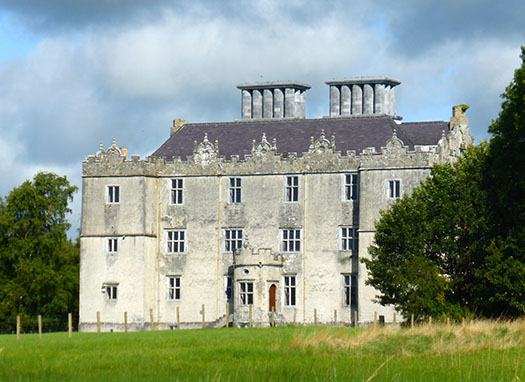
Portumna Castle – the mighty chimneys suggest even mightier heating bills. Photo: W M Nixon
Home sweet home, but far from the Baltic Sea – Triskel and her live-aboard skipper. Photo: W M Nixon
By complete contrast, back at the Castle Harbour we met up with a Polish sailor who had cruised the Baltic before he set off to start life anew in Ireland eleven years ago, and when he discovered the Shannon and all its attractions he moved aboard a little sailing cruiser eight years ago. He has lived on her ever since, in and around the Shannon lakes, and is well content, though when I guessed his boat might be an Anderson of some sort, he was very positive in making sure that I realized his beloved Triskel was an Anderson 22 Mark 2, and not one of the inferior original Mark 1 versions.
Having been bemused by contemplating the heating bills for Portumna Castle, I didn’t find out his name before he headed out of port, but by this time our skipper also reckoned it was time to go. David had an app which gave weather predictions so accurately that he could tell you exactly when the rain would fall on different parts of the lake, precisely how big the rain-drops would be, how long they’d be falling, and how much wind would be in the midst of them. Or so it seemed to the rest of us. But somehow he got us all moving together aboard ship out of Portumna Castle Harbour at morning coffee time, and we proceeded southwards down the splendid lake almost entirely in sunshine as big dark rain squalls ran north along the Atlantic seaboard to the west, while over to the east it was pitch black over mid-Tipperary and they’d some flooding. Yet aboard Slaney Shannon Star, this helmsman on the flybridge managed to get a bit of a suntan during the two hours plus passage down to Mountshannon.
From the lake, you get glimpses of other’s people’s little bits of paradise – this mini-port is one of the East Clare shore north of Mountshannon. Photo: W M Nixon
Lough Derg is 40 kilometres long (it’s 23 land miles in old money from Killaloe Bridge to Portumna Bridge) and around 20 kilometres across its widest part, but it follows the contours as befits a developing river valley to provide a handsome convoluted lake. While the coastal scenery is fairly flat up about Portumna, as you get south past Dromineer the land is rising to port and particularly to starboard, with the final approaches to Killaloe between the Arra Mountains and Slieve Bernagh becoming quite spectacular.
In classic cruising style, our skipper had decided the best way to deal with the lake was to get down to Killaloe on the first day, and then cruise back to Portumna at a much more leisurely pace. But even when you’re trying to log the miles, Lough Derg offers ample choices for quick stops, and as the weather app was talking about some decidedly lively southwest to west breezes later in the afternoon, the logical place for a stopover was Mountshannon.
This would mean that if the top did come off conditions for a while, we’d be located so that we could hold round a weather shore to get a smooth passage into the long “reverse estuary” down to Killaloe. But first, we’d to enjoy Mountshannon. It’s headquarters of the Iniscealtra Sailing Club (Iniscealtra is the neighbouring holy island, complete with Round Tower and a place of pilgrimage), but Mountshannon has the additional advantage of being serenely south-facing over a fine but sheltered bay, and it is home to an impressive fleet of yachts lying in a classic anchorage. There are the likes of Hallberg Rassys among them, and if you wondered what on earth a Hallberg Rassy ocean cruiser is doing on a lake, we suggest you get to Mountshannon and understanding will come.
An anchorage for proper yachts – some impressive craft are lying to moorings in Mountshannon. Photo: W M Nixon
We meanwhile understood that rain was coming, and fast, so after a neat bit of berthing even if I do say so myself, we nipped up to the village inn and took aboard broth and stews while the rain battered the street outside, and German and English visitors supped their pints of Guinness with that happily bemused little smile you’ll see on the faces of tourists who have discovered an Irish inn exactly as they hoped it would be, including the rain outside.
But even that cleared on cue, and we needs must visit Mountshannon’s unique attraction, the combined labyrinth and maze. A perfect opportunity for junior scouts to guide the oldies about. However, the wind had come through as expected, so much so that Mountshannon’s famous white-tailed sea eagles appeared to be grounded for the afternoon. But though Slaney Shannon Star was sitting serenely in a wellnigh perfect berth for a stormy night, the menfolk were just too interested in seeing how she’d perform in a real breeze of wind, with a bit of a sea running, to stay on in the same place.
Slaney Shannon Star snugly berthed at Mountshannon. The front is going through, and the wind has veered, but there’s enough of it to keep the sea eagles of Mountshannon grounded. Photo: W M Nixon

There really is a maze at labyrinth at Mountshannon, but it takes an aerial photo to show them properly
“It’ll only be slightly lumpy for a few minutes” was the mantra. And it has to be said the old girl coped superbly, though fortunately all warps had been lashed in place, as for a little while -until we were feeling the shelter of the Clare coast in under the delightfully-named Ogonnelloe – some quite substantial quantities of Lough Derg were sweeping at speed over the Slaney Shannon Star.
Sea test – Slaney Shannon Star finds a bit of a sea running on the lake. Photo: W M Nixon
For a while, quite a lot of Lough Derg was sweeping over Slaney Shannon Star on passage from Mountshannon to Killaloe, but it didn’t take a feather out of this able boat – those towels are laid out to dry, not to cope with leaks. Photo: W M Nixon
But in the Killaloe estuary, relative peace returned, the black clouds raced away to the east, the sun came out with a rainbow, and there was this sense of approaching somewhere important, heightened by the quality and variety of the lakeside and hillside houses. Some people find this Irish scattering of houses, each in its own little world, to be something of an irritation among some rather fine scenery. But I like it. There’s more than enough empty uninhabitable wilderness in the world, and except for the most spectacular mountains, Irish scenery is enlivened by houses dotted here and there in such a way that you think pleasantly of the agreeable way of life that might be found in them.
The storm squall has passed, and the lush country of the Tipperary shore is seen at its best with a rainbow in the approaches to Killaloe. Photo: W M Nixon
Once we were into the smooth water, Madam got on the phone to suss out the possibilities of an “Objective Achieved” supper at the renowned Cherry Tree on the Ballina side of Killaloe, and of course chef patron Harry McKeown himself answered the phone and recognized her voice immediately. But he went through the formality of booking a table for six in impersonal style before letting her know her cover was blown.
Whatever about Georgina’s problems in dining anonymously, for the rest of us it made for a idyllic evening, with the boat berthed as conveniently as possible at the berth generously provided by the Lakeside Hotel, the shortest walk imaginable to the Cherry Tree, a riverside window table to admire a sister-ship berthed directly across the water on the Killaloe side, and food glorious food while the light lingered in a fair approximation of a summer’s evening.
Our first berth at Killaloe was at the hospitable Lakeside Hotel on the Ballina shore. Photo: W M Nixon
Mission accomplished – the team have reached The Cherry Tree for dinner in Killaloe. Photo: W M Nixon
An interest in visiting Killaloe Cathedral in the morning had been expressed, so lo and behold our thoughtful skipper moved the boat across river in the morning on his own while the rest of us were still bestirring ourselves, thereby removing the need to walk across Killaloe’s ancient but much overworked bridge. It suffers from ludicrously excessive traffic – the lovely little riverside town does really urgently need a by-pass and the long-planned new bridge to the south. But St Flannan’s Cathedral well exceeded expectations. It’s of very modest size for anyone expecting a Shannonside version of Chartres or York Minster. But we knew it well from the outside, yet going in was a revelation, a haven of total peace in this Cathedral of the Waterways.
The Cathedral of the Shannon – St Flannan’s at Killaloe is on the banks of the old canal to Limerick which pre-dated the Ardnacrusha development. Photo: W M Nixon
A soothing place - Killaloe Cathedral. Photo: W M Nixon
Busy place - Killaloe is very much the southern capital of the Shannon waterway. Photo: W M Nixon
There seemed to be an unspoken agreement that we weren’t going to break the spell of peace by walking across the bridge, but as this meant the kids couldn’t avail of the playground on the Ballina side, it was a case of up sticks and away from the impressive new Waterways Ireland pontoons on the Killaloe side, and off we went north and east to Garrykennedy with its handy playground, on the way passing learner sailors in action off the University of Limerick’s Activity Centre on the Clare shore, and then – for it was a pleasant sunny sailing day after Wednesday’s weather kerfuffle – we passed a real live sailing cruiser going on her merry way, plus several powercruisers.
With lighter winds, sailing can resume at the University of Limerick Activity Centre near Killaloe. Photo: W M Nixon
Waterside paradise - lakeshore house near Killaloe. Photo: W M Nixon
The guess is it’s a Halcyon 23 enjoying the breeze on Lough Derg – and taking in one’s fenders is optional on the lakes. Photo: W M Nixon
All the little ports about Lough Derg have their own individual character, and Garrykennedy is about as different as possible from Killaloe, which in turn is very different from Mountshannon, while Dromineer – where we were to spend the night – is different again.
But most of the ports popular with today’s sailors on Lough Derg have it in common that once they were part of a busy waterways transport system, each with its own little mini-harbour which could accommodate the barges which might have come all the way from Dublin via the Grand Canal. The cream of the fleet were engaged in the sacred task of conveying Guinness’s Porter from St James’s Gate Brewery all the way to the connoisseurs of Limerick, whose tastes were and are so pernickety that when any variant in any product is contemplated in the Guinness organisation, somebody always wonders how it will do in Limerick…
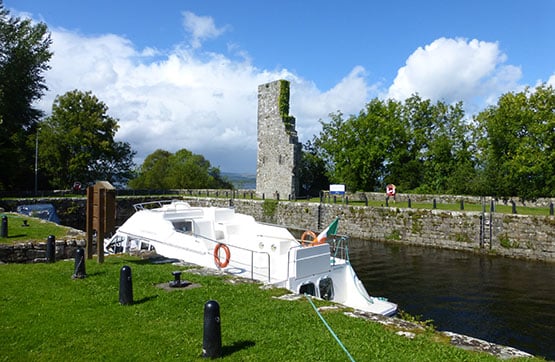
Garrykennedy’s little harbour was created inshore of the 15th Century castle of the O’Kennedys. Photo: W M Nixon
Larkins of Garrykennedy is one of the most popular food pubs on Ireland’s inland waterways. Photo: W M Nixon
The décor in Larkin’s of Garrykennedy includes this superb half model of a Shannon One Design OD made by Reggie Goodbody of Dromineer. Photo: W M Nixon
So keen is Limerick to get its Guinness that in a storm one winter a canal boat (they were never called barges in their working days) headed out after sheltering in Garrykennedy and sank off Parker Point taking some of her crew down with her, but that’s a sad story for another day. For we got into Garrykenedy on a sunny day to find a handy berth in the old harbour, a good lunch in Larkins, and a classic Children’s Playground with real old-fashioned swings where Matthew and Julia proved fearless.
By the time you’re a day or three into your Waterways holiday, you lose track of time, but I think it was later that afternoon when the Slaney Shannon Star headed in the sunshine across to Dromineer. There, we found the most-sheltered spot at the quayside in the harbour was entirely taken up by a slovenly-berthed J/24 which, if it had been secured in a more thoughtful manner, would have left plenty of room for other boats.
However, the nearest handy berth put us right beside the playground, so bonus points for Dromineer. And then, as we had access to sheltered water, it was time for a bit of fun with the outboard dinghy, which was a winner with the kids, who were soon helming it with skill. You’d expect that of Matthew – he has helmed a Howth Seventeen – but Julia at just three years old was a very cool and quick learner.
The berth at Dromineer was ideal for family cruising, being right beside the children’s playground. Photo: W M Nixon
Outboard dinghy sport at Dromineer. Photo: W M Nixon
Matthew in charge, and The Diva not too pleased. Photo: W M Nixon
The Whiskey Still at Dromineer is a Lough Derg institution. Photo: W M Nixon
An overnight in Dromineer means supper at The Whiskey Still, and very good it was too, a real local which comes pleasantly to life as the evening draws on, and lots of folk to talk to about this intriguing place, which in the great days of Waterways transport, was by way of being the main port for North Tipperary. But since 1835 it has also been the home of Lough Derg YC, whose fine clubhouse was taking a brief rest between the excitements of the annual Lough Derg week and the imminent arrival tomorrow of the international fleet of cruising-racing Wayfarer dinghies.
The last walk of the day for Pippa discovered an energetic game of kayak polo under way off Dromineer’s little beach (yes, they really do have a beach, the immaculately-kept Dromineer has everything) but later that night the breeze freshened again and our fenders were squeaking a bit. We couldn’t be having that at all, so the skipper found us enough room along the other quay for us to warp into a berth where the breeze held us noiselessly off the wall for a night of peace.
Kayak polo at Dromineer. Photo: W M Nixon
Dennis Noonan of Round Ireland race fame on his Pegasus 800 Photo: W M Nixon
By this time we were so totally into Waterways time that I haven’t a clue when we left Dromineer next day, but we seem to have crowded several days of living into a morning. The playground had to be given a thorough work-over, the dinghy had to be taken out for a spin at least twice, then Pippa had her morning walk along to Shannon Sailing’s secluded marina where of all people we met up with the great Dennis Noonan of Wicklow and Round Ireland Race fame. He was aboard his able little Pegasus 800 which is for sale, and is a fine sailing cruiser if you’re interested in a proper yacht with full standing headroom. But there was little enough time to discuss boat sales, for in real life Dennis is a market gardener of long experience, so he and Georgina were immediately at it yakking away about genuine local produce and how to get people to appreciate what their neighbourhood can produce in season.
I meanwhile wandered off meet up with Robbie the Main Man in the workshop, and soon discovered he was the owner of an enormous 95ft boat – the Spera In Deo - which was lying in Dromineer harbour, a former Dutch mussel dredger which he had discovered in a ruinous state in Donegal after a fire. He was able to make her sufficiently seaworthy to bring her south along the Atlantic seaboard and into the Shannon crewed by all the usual gallant suspects, and while he still has much cosmetic work to do to the exterior, he has fitted out the interior in the most extraordinary way to make her the biggest four berth motor-cruiser in the world, as there are two enormous en suite double cabins - one with a Jacuzzi - while the headroom in the vast main saloon is theatrical in scale.
95ft of the biggest four berth motor cruiser on the Shannon – the Spera In Deo at Dromineer. Photo: W M Nixon
To grasp the scale of the Spera In Deo’s interior, you have to realize those are full-height interior doors for a house. Photo: W M Nixon
Eventually I was reunited with my brood in the Lake Café right on the harbour. It’s open from 8.30am until 5.0pm, which makes for a very civilised little village arrangement as The Whiskey Still then opens up for food. Declan & Fiona Collison, who run the Lake Café, used to run The Whiskey Still, so they know the Lough Derg hospitality scene inside out. But like everyone along this ancient waterway, they are as keen to talk about its fascinating past are they are interested in its present and future, and the Lake Café’s walls are adorned with aerial photos of Dromineer from around 1967 which really do bring home to you how much Ireland has moved on during the past half century.
Breakfast in Dromineer – Georgina, Matthew and Julia have the first of the day’s five meals….. Photo: W M Nixon
Dromineer as it was in 1967 – photo courtesy Lake Café.
Heading up-lough in “vivid sunshine”. Photo: W M Nixon
Not everything has come through intact or improved, however. Heading up-lough later that day in vivid sunshine, we went close past Illaunmore, Derg’s biggest island, where very many years ago we discerned what looked like a tiny creek leading to a little harbour. Though it was obviously private, our curiosity got the better of us, and we negotiated our motor-cruiser through the narrow gap to find a harbour. There was a small waterside chalet and a man out for a walk with his very tame golden pheasant, which we later learned was called Sammy. This was the late Martin Winston, and Illaunmore was the love of his life. He was never happier than when on his own island. But that was a long time ago. Martin Winston is long gone. And as far as we could see, the lovely little harbour where we were made so welcome with a fantastic spontaneous party generated within minutes, it now all seems completely overgrown.
But while the harbour in Illaunmore may have disappeared in the undergrowth, the other port of that day’s cruising so long ago, Terryglass, has come on with leaps and bounds. Indeed, when we visited Illaunmore with its fine little harbour, there was virtually no harbour at all at Terryglass, you berthed in a sort of creek where cattle came to drink lake-water. And the first time we were there being Hallowe’en night, the track up to the village where a friend had just bought the pub was quite a spooky experience.
Terryglass has become a busy port in the past three decades. Photo: W M Nixon

It’s always an irresistible challenge to try and disappear into the reeds. Photo: W M Nixon
But today Terryglass is one of Lough Derg’s more glamorous ports, while it’s a special place for David and Karen, as they were married in the lovely church in the village, that church whose spire is “Conspic” from all parts of the north end of the lake. But when you’ve a couple of lively kids, there’s no time to be sad or serious about the old days and disappeared harbours or new harbours and whatnot. They’ve splendid reed beds at Terryglass, and disappearing completely into the reeds is a natural challenge for youngsters with an outboard dinghy, so that was on the agenda before we ambled up to the village and supper in the Derg Inn.
It wasn’t a restaurant crawl we were on by any means, but brisk days on the lake are great for the appetite. That last day was typical. We’d the usual good breakfast on board, then after everyone went off on their various pursuits, we’d one of those light “Meals-without-a-Name” with the Collisons at the Lake Café, as their baking is superb. Then when we berthed in Terryglass, somehow Karen had another meal-without-a-name ready on the saloon table, followed by more reed-bashing-by-boat, and then with the kids needing an early meal followed by a reasonable bedtime, we fed well but early in the Derg Inn.
Not for the faint-hearted (1): The Pineapple Boat in the Derg Inn. Phot: W M Nixon
Not for the faint-hearted (2): On the swings at Terryglass. Photo: W M Nixon
There, I fearlessly rounded out the feast with a Pineapple Boat with strawberry ice-cream, raspberry coulis and cream – definitely not a nibble for the faint-hearted. Then back at the harbour where the kids went to the limit and beyond on old-style swings in the playground, with people arriving down to join their Terryglass-based cruisers for the weekend we could admire an extraordinary selection of dogs even unto an Irish wolfhound, and not a lifejacket among them except for Pippa. And after all that, the little people went willingly to bed, and in truth the rest were soon headed the same way.
Canine old mates of Terryglass harbour. Photo: W M Nixon
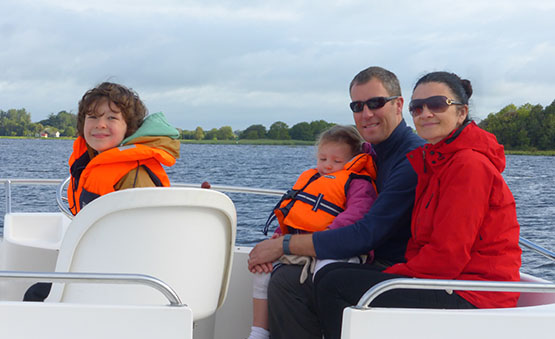
The end of a busy week – Mattthew, Julia, David and Karen on the final morning. Photo: W M Nixon
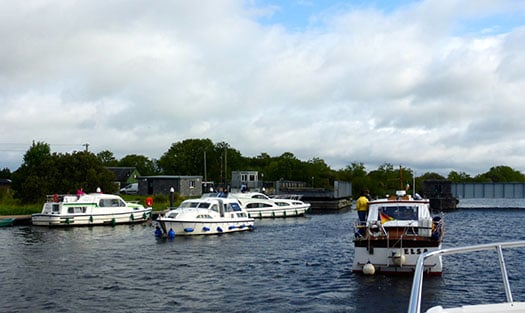
The bridge opening at Portumna is both a beginning and an end. Photo: W M Nixon
Changeover Saturday at a hireboat base is so busy there’s not time to be sad that it’s all ending. We were perfectly on time across from Terryglass for the 0945 bridge opening at Portumna, there was a berth stern-to right beside the cars, there was the usual final check round to make sure we’d left nothing behind, and then we were gone, only pausing briefly to hope that whoever next took the gallant Slaney Shannon Star down the short channel to the river and the lake was going to have at least half as good a time as we’d had.
But now the grandparents weren’t too tied to time. We could go home at leisure, ambling by road on up the Shannon, stopping here and there at river ports which are very different in character from lake harbours. Yet all have their special charms, so it was after dark when we finally got home. It wasn’t until Sunday that we finally opened Saturday’s Irish Times. And there was the announcement that Peter & Mary Ward’s fantastic weekly display of everything good in the Milk Market in Limerick had won the prize for the Best Market Stall in Ireland.
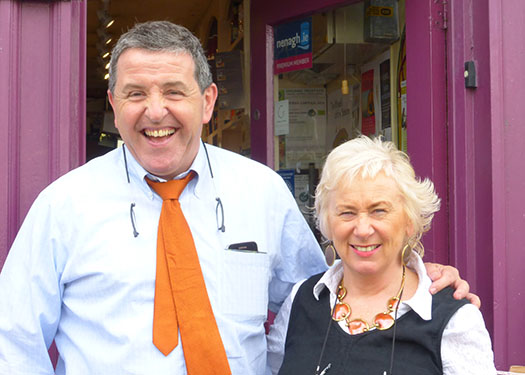
Winners! Peter & Mary Ward of Country Choice in Nenagh. Photo: W M Nixon
#biodiversity – Students from Kilfinane National School gathered along the banks of the River Loobagh in Limerick yesterday (Monday) as part of a new environmental education initiative being administered by Limerick City & County Council.
'StreamScapes Loobagh' is aimed at promoting the aquatic and biodiversity resources of the River Loobagh Catchment in south County Limerick.
The visit by the school children was followed later in the day by a visit to the river by members of the local community. The Kilfinane event is one of three taking place over the coming weeks with others scheduled for Ardpatrick on Monday 11th May and Kilmallock on Monday 18th May.
"The children and their teachers really enjoyed their exploration of the River Loobagh this week. Amongst the interesting wildlife species identified and documented on the stretch of river by the Well Road were salmon and trout fry, juvenile glass eel, or "elvers", - all the way from the Saragossa Sea - and crayfish. They also found a range of stonefly and mayfly nymphs and cased caddis fly larvae which points towards a very high quality river environment at that location," said Anne Goggin, Senior Executive Engineer with Limerick City and County Council.
"We are utilising the award-winning 'StreamScapes' programme to enable communities of the River Loobagh to learn about the important links between high status local water quality and human health, thriving socio-economy, higher value agricultural produce and biodiversity. We are excited to be producing this programme and encourage people to engage," added Ms. Goggin.
The initiative is backed up by a dedicated local environmental booklet which is being distributed to communities in the Loobagh catchment area.
Upcoming Community Evenings:
- Mon 11th May, Ardpatrick: meet at 7pm in church car park. Visit to river followed by meeting and refreshments in the community hall.
- Mon 18th May Kilmallock: meet at 7pm in Car Park of Deebert House Hotel. Visit to river followed by meeting and refreshments afterwards in the hotel.
Fast flow at Portora, Enniskillen
#Erne – As a result of fast river flow On the Erne system at Enniskillen, Portora Lock is presently closed. Also, a defective sluice gate on the weir means there are fast flow rates in the vicinity of the lock. Waterways Ireland has issued a warning to Masters to proceed with caution if navigating in the vicinity of the lock.
Forty Boats Prepare for Liffey Cruise
The boats are mostly modest sailing yachts with some motor cruisers, typically eight to twelve metres long with up to six people aboard. They come from ports on the East coast of Ireland between Arklow and Skerries.
The sailors will spend the afternoon visiting other boats, renewing friendships and comparing notes. Some will use the opportunity to explore the city centre from this unusual perspective.
There are organised visits to the Jeanie Johnston and the Guinness Storehouse. A special attraction this year is a guided tour of the docks in an inflatable boat, by Sea Safari.
In the evening the whole group, about a hundred people, will gather for dinner in a nearby hotel. Formalities will be limited to a review of the season in general and the summer cruise in Strangford Lough, but the party is likely to continue until late.
Most sailors will spend the night aboard their boats. On Sunday morning commodore Derek Harris will say mass aboard the Jeanie Johnston. The bridges will open once more at noon, and the fleet will disperse to their home ports.
This annual event is organised by the Cruising Association of Ireland with the co-operation of the Dublin Docklands Development Authority and Dublin Corporation.
The Cruising Association of Ireland supports and represents the cruising community in Ireland, both power and sail (www.cruising.ie). Contact Derek Harris 087 6740334 [email protected], or Simon Parker 0872497859 [email protected]
Last of National Rowing Heads takes place in Belfast Today
There are 148 crews over the three races starting with pairs and sculls, then doubles and fours and finishing in the afternoon with eights and quads. The third race features 35 eights and 26 quads.
The big race of the day, the men's senior eights, which starts at 3.45 pm, will feature a high intensity race between the two Queen's University eights. The A Queen's crew, with new strokeman, Mike Ewing, have been relatively the same crew for the last three years. This is the crew which mounted serious challenges to the victorious NUIG team at the Irish Rowing Championships, narrowly missing out on a national senior eight by a mere few feet on two occasions. The A team's Ewing won a Wyfold cup (men's coxless four) at Henley last year.
The women's intermediate eights should prove interesting with a crew entered from St Andrews in Scotland who will be up against Queen's University Ladies and St Michael's, Limerick.
The men's junior 16 eights sees all the Ulster crews up against each other whilst the men's junior 18 quads sees Blackrock College, Dublin, Shandon ,Limerick and Offaly Rowing Club take on the Ulster schools.
Eight crews will contest the men's Master's pennant (over 28s) with Galway, Bann and Athlone pushing the Belfast-based masters crews, Belfast Boat Club, Belfast Rowing Club and the Lady Victoria Boat Club, all the way. The former Queen's ladies rower ,Frenchwoman Solange Garrais is bringing a men's Masters and a women's Masters quad from Aviron Grenoblois, France to compete.
The 10.45 am and 13.15 pm races start at the Albert Bridge in Belfast and finish at Queen's boathouse at Stranmillis. The 15.45 pm race starts at the Odyssey building in Belfast Harbour and finishes at Queen's boathouse at Stranmillis. There are viewing points along the full length of each race.
The official start to the regatta season takes place on Saturday 2nd April with the Neptune regatta at Islandbridge, Dublin.
Click this link for Irish Rowing detailsClick this link for the Latest Rowing News
Queen's and Portora Impress at Erne Head
Two men’s senior eights from Queen's University slotted into the first two slots at the Erne Rowing Head of the River at Enniskillen. The junior 18 quadruple of the host club, Portora, had a fine result, finishing joint eighth overall.
Erne Head of the River, Enniskillen
Overall: 1 Queen’s A men’s senior eight 19 minutes 53 seconds, 2 Queen’s B men’s senior eight 20:21, 3 University of Limerick/St Michael’s men’s senior eight 20:40, 4 Trinity men’s intermediate eight 20:59, 5 Bann men’s junior 18 eight 21:09, 6 Methodist College, Belfast men’s junior 18 eight 21:47.
Men, Eight – Senior: 1 Queen’s A 19:53, 2 Queen’s B 20:21, 3 University of Limerick/St Michael’s 20:40. Intermediate: Trinity 20:59. Novice: 1 Trinity 21:47, 2 Queen’s 22:38, 3 Queen’s B 24:51. Junior 18: 1 Bann 21:09, 2 Methody 21:47, 3 St Joseph’s 22:02. Junior 16: St Joseph’s 23:50. Masters: Belfast BC (E) 24:06.
Four/Quadruple Sculls – Senior: 1 Belfast RC (quadruple) 23:01, 2 LSC (quad) 24:45. Intermediate: 1 Trinity (quad) 22:17, 2 Queen’s (coxed four) 23:39, 3 University of Limerick (quad) 23:59. Junior 18: 1 Portora (quadruple) 22:02, 2 Commercial (quad) 22:51, 3 Portora (coxed four) 22:56. Junior 16: Bann (quad, coxed) 24:05.
Women, Eight – Senior: 1 Trinity 23:42, 2 NUIG 23:51. Intermediate: 1 Queen’s 23:45, 2 Trinity 26:02, 3 Methody 26:16. Novice: 1 Queen’s 25:07, 2 Trinity A 26:29, 3 Trinity B 26:40. Junior 18: 1 St Michael’s 24:41, 2 Portora A 27:24. Masters: Belfast BC (D) 25:39
Four/Quadruple – Senior: 1 Portora (quadruple) 24:32, 2 Trinity (coxed four) 27:28, 3 Garda 28:11.
Click this link for Irish Rowing detailsClick this link for the Latest Rowing News
Minister Lenihan Supports Environmental Initiative on Dublin's River Dodder
In preparation for the field trip Des Chew, Project Manager of the Dublin Angling Initiative visited the school and gave the pupils a talk on water quality, the lifecycle of trout and the art of fly-fishing. The pupils then participated in a field trip along the River Dodder, starting at Rathfarnham shopping centre and finishing at the confluence of the Dodder and Owendore rivers at Bushy Park. Minister Lenihan was joined by TV celebrity and angler Derek Davis.
Fisheries staff from Dublin Angling Initiative and Inland Fisheries Ireland took kick samples and were ably assisted by Gerry Heaslip and Brian McDonagh of the Dodder Angling Club. The children identified invertebrates and their delight could be heard far and wide as they found many different species of stonefly and caddis fly! Looking at water pollution indicators, the children could establish that the presence of these different types of invertebrates indicated the good water quality in the river. This is not surprising given the very healthy stock of wild brown trout in the river.
Minister Lenihan, remarked:
'It is wonderful today to see the young people out learning about their local river. The River Dodder is a very important river in south Dublin, it has good water quality, contains a healthy population of wild brown trout and is a wonderful angling resource.
This is in no small part due to the excellent relationship that the Dublin Angling Initiative and Inland Fisheries Ireland have with the Dodder Angling Club'.
Following this the children were given information packs on fish species, invertebrates and fish species posters. St. Pius X School has participated in Inland Fisheries Ireland's 'Something Fishy' programme in previous years and were thrilled to take part in such an exciting field trip of their local river.
The 'Something Fishy' project was developed by Inland Fisheries Ireland (formerly the Central and Regional Fisheries Boards) in association with Blackrock Education Centre and has proved a highly successful way of encouraging young people to take an interest in Irish fish species, their local environment and habitat. In 2010 almost 1,000 young people participated in the Something Fishy programme within the Eastern River Basin District.
Cork Crews Rise to the Top at Cork Head
Cork crews saw off rivals from far and near at the Cork rowing Head of the River at the Marina on Saturday. UCC’s men’s senior eight were the fastest men’s crew – by 1.3 seconds from De Maas of Rotterdam, a masters eight. The fastest women’s crew was Cork Boat Club’s junior 18 eight, adjudged just .8 of a second quicker than UCD’s women’s senior eight. The fastest men’s single sculler was John Keohane of Lee Valley and Karen Corcoran-O’Hare of Shandon was the fastest women’s single sculler.
Cork Head of the River, The Marina, Cork, Saturday
Overall: 1 UCC men’s senior eight 12 minutes 6.7 seconds, 2 De Maas, Rotterdam men’s masters eight 12:08.0, 3 UCC men’s novice eight 12:25.9, 4 UCD men’s novice eight 12:42.4, 5 Presentation College men’s junior eight 12:44.3, 6 Muckross intermediate eight 12:49.9.
Men, Eight – Senior: UCC 12:06.7. Intermediate: Muckross 12:49.9. Novice: UCC 12:25.9. Junior: Presentation 12:44.3. Junior 16: Cork 13:21.2. Masters: De Maas 12:08.0.
Fours – Senior: Cork/Garda 12:53.6. Intermediate: UCC 13:40.6. Novice: Cappoquin 13:43.9. Junior 18, coxed: Presentation 13:04.0
Pair – Junior 18: Presentation 14:58.7. Masters: De Maas 13:09.9. Coastal – Novice: Ahakista 17:28.7.
Sculling, Quadruple – Senior: Shannon 13:50.8. Novice: Shannon 15:07.4. Junior 18: Cork 13:05.3. Junior 16: Cork 13:15.2.
Double – Intermediate: Cork IT 13:41.6. Junior 18: Clonmel 13:53.9. Junior 16: St Michael’s 15:04.4. Coastal – Novice: Kilmacsimon 16:17.2.
Single – Senior: Lee Valley (J Keohane) 14:16.4. Intermediate: Lee (O’Connell) 14:53.4. Novice: Lee (O’Connell) 14:37.9. Junior 18: Workmen’s (Burns) 14:33.0. Junior 16: Shandon (Casey) 15:08.9. Masters: Skibbereen (Barry) 15:40.07. Coastal – Novice: Kilmacsimon 17:33.6
Women – Overall: 1 Cork junior eight 13:40.0, 2 UCD senior eight 13:40.8, 3 St Michael’s junior eight 13:54.1.
Eight – Senior: UCD 13:40.8. Novice: UCC 14:25.4. Junior 18: 1 Cork 13:40.0. Junior 16: Clonmel 16:21.0.
Four – Senior: Muckross 14:15.9. Intermediate: UCC 17:00.9. Novice: UCC 16:29.8. Masters: Skibbereen 22:34.9.
Pair – Junior 18: St Michael’s 15:00.2.
Sculling, Quadruple - Novice: Shannon 15:51.4. Junior 16: St Michael’s 15:16.5.
Double – Intermediate: UCC 16:15.1. Junior 18: Cork 14:43.9. Junior 16: Lee 15:42.3. Masters: Cork 15:38.3.
Single – Senior: Intermediate: Shandon (K Corcoran-O’Hare) 15:39.7. Junior 18: Lee (Kearney) 16:52.1. Junior 16: Lee (Hamel) 16:13.6. Masters: Cork (Crowley) 17:49.2.
Coastal: 1 Kilmacsimon men’s novice double scull 16:17.2, 2 Ahakista men’s novice quadruple coxed scull 17:28.7.
Click this link for Irish Rowing detailsClick this link for the Latest Rowing News





























